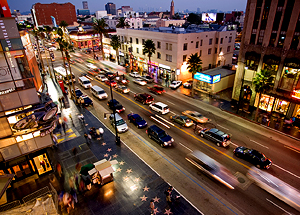
Alfred Uhry’s Driving Miss Daisy is perhaps best known from the 1989 film
adaptation which starred Jessica Tandy and Morgan Freeman, and which
won Miss Tandy the Oscar at the age of 80. However “Miss Daisy” made her
first appearance in a tiny off-Broadway theater in 1987, with Dana Ivey and
Freeman creating the roles of Miss Daisy and her chauffeur Hoke. That Uhry’s
tale of an elderly Southern Jewish widow and the African American driver
foisted upon her by her adult son could work equally well on the big screen
and on a small stage is testimony to its power. Now, McCoy Rigby
Entertainment’s revival at the La Mirada Theatre for the Performing Arts
proves that Driving Miss Daisy is equally successful performed on a Broadway-
sized stage, especially in the hands of TV icon Michael Learned and her 3-time
Miss Daisy costar Lance C. Nichols, under the assured direction of Brian Kite.
The current production brings back fond memories of the film’s most
unforgettable scenes: the fender-bender that brought Hoke into Miss Daisy’s
household, Miss Daisy’s initial stubborn insistence on going to the Piggly Wiggly
by trolley, her discovery that Hoke has filched a can of salmon from her pantry,
Hoke’s refusal to join Miss Daisy at the Martin Luther King dinner because her
invitation came too late, Miss Daisy’s heartrending admission to Hoke that
“You’re my best friend,” ex-schoolteacher Miss Daisy’s demented search for
school papers decades after her retirement, and Hoke’s final visit to
nonagenarian Miss Daisy in her nursing home. At the same time, Miss Daisy and
Hoke’s story seems fresh and new as performed by Learned, Nichols, and L.A.
favorite Morgan Rusler.
This is Michael Learned’s third time out as Miss Daisy, and Nichols’ fourth, and
their experience shows in exquisitely nuanced and layered performances.
Learned’s Miss Daisy is the crotchety old lady you love to hate, or hate to
admit that you love. When she crashes her car, she blames it on the vehicle,
and when her son gently insists that she herself is at fault, she lashes out,
“You’re just saying this to be hateful!” Anyone who’s cursed out an “old fogey”
driving way under the speed limit will chuckle at Miss Daisy’s axiom, “The slower
you go, the more you save on gas.” Any driver who’s ever been blamed for
getting lost by the map-reader in the back seat will empathize with Hoke
when Miss Daisy keeps giving him wrong directions and the two keep getting
more and more lost.
Learned so disappears into the role that you forget that this is the actress who
epitomized loving motherhood on the Waltons for so many years, especially
with the passage of time as age takes its toll on Miss Daisy. Likewise, the
energetic and erudite Lance Nichols who answered questions at Tuesday’s
Q&A bears little in common with the mellow, uneducated Hoke. If one
audience member commented that at times she felt she was seeing Morgan
Freeman on stage, it is that the role so transformed both actors that each,
independently, became the very character that Alfred Uhry so clearly and
richly delineated in his script.
One of the reasons why Uhry’s play is such a winner (it scored the Pulitzer Prize
for Drama) is that, despite their very different educational backgrounds and
stations in life, Miss Daisy and Hoke are truly each other’s equals. In the same
vein, the role of Hoke offers an actor equal challenges and rewards to those
offered an actress by the role of Miss Daisy.
Hoke Coleburn is a man of great insight, intelligence, and wit, as when,
referring ironically to some stingy Baptists he’s met, “Them’s the people who’s
callin’ Jews cheap.” Or when, a propos Miss Daisy’s grudging agreement to let
him chauffeur her around, Hoke declares, “Only took six days. Same time it took
the Lord to make the world.” Or when he tells his boss a plain and simple, “Miss
Daisy, you needs a chauffeur and Lord knows I needs a job. Let’s just leave it at
that.” Then, there’s Hoke’s laugh-getting, oft-spoken mantra “That’s for him
and me to know” which he trots out whenever Miss Daisy asks how much
Boolie’s paying him, or later, how much he paid for Miss Daisy’s used car. Hoke is
a man who has spent little time in school but has learned much about life,
people, and self worth. When a humiliated Hoke asks Miss Daisy to let him take
a break from a long interstate drive in order to “make water” in the bushes (no
gas station will let a black man use their facilities), it comes as a particular
shock because the way we have come to see him is so different from the way
he is seen in the deep South of half a century ago.
Driving Miss Daisy the movie featured a large cast which included Boolie’s wife
Florine, Miss Daisy’s longtime cook Idela, and others who are only referred to in
Uhry’s play. Miss Daisy’s son is very much present in the stage version, however,
and portrayed here by Morgan Rusler, one of our most versatile and in-
demand character actors. It’s always a pleasure to see a Rusler performance,
as it is here to watch his long-suffering Boolie react once again to yet another
of his mother’s quirky behaviors, or to observe his respectful business dealings
with Hoke.
Though Learned and Nichols have played their roles before, and opposite
each other, director Brian Kite is new to the play, and just as he did when
directing Proof, Kite shows a real talent in helping his actors shape multi-leveled
characterizations. He also keeps the 24 scene changes moving swiftly and
cinematically, with the invaluable help of John Iacovelli’s mobile set, Craig
Pierce’s evocative lighting, and Craig Wolynez’s sound design which
incorporates violin/cello/banjo music from the original off-Broadway
production. Judy Jou’s costumes are her usual fine creations, and it is
fascinating to compare the original sketches in the Miss Daisy program with
their physical incarnations on the stage.
As was the case with Sylvia, the most recent McCoy Rigby production, Driving
Miss Daisy proves once again that the La Mirada Theatre for the Performing
Arts ranks right up with the Pasadena Playhouse in presenting exquisitely
realized straight plays on a Broadway scale proscenium stage. Though it can
be an equal pleasure to see a 99 seat production or one at a mid-sized
theatre, there’s something about a large classically designed theater that
makes seeing a play there a special treat. When it is a production of the
caliber of Driving Miss Daisy, it’s something to shout about.
La Mirada Theatre for the Performing Arts, 14900 La Mirada Boulevard,
La Mirada.
www.lamiradatheatre.com
–Steven Stanley
February 5, 2008
Photos: Michael Lamont




 Since 2007, Steven Stanley's StageSceneLA.com has spotlighted the best in Southern California theater via reviews, interviews, and its annual StageSceneLA Scenies.
Since 2007, Steven Stanley's StageSceneLA.com has spotlighted the best in Southern California theater via reviews, interviews, and its annual StageSceneLA Scenies.







 COPYRIGHT 2025 STEVEN STANLEY :: DESIGN BY
COPYRIGHT 2025 STEVEN STANLEY :: DESIGN BY